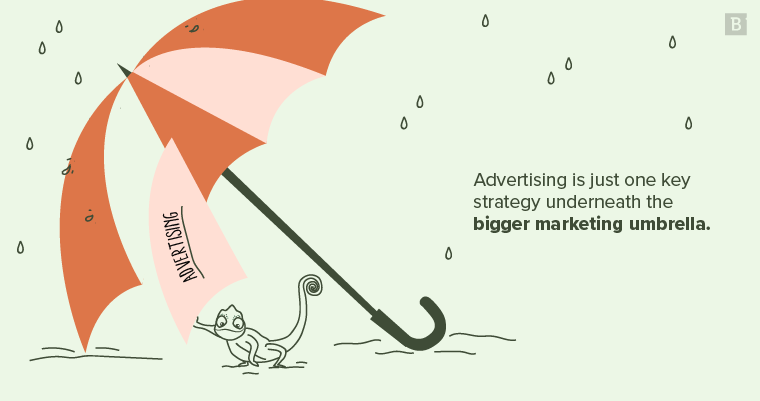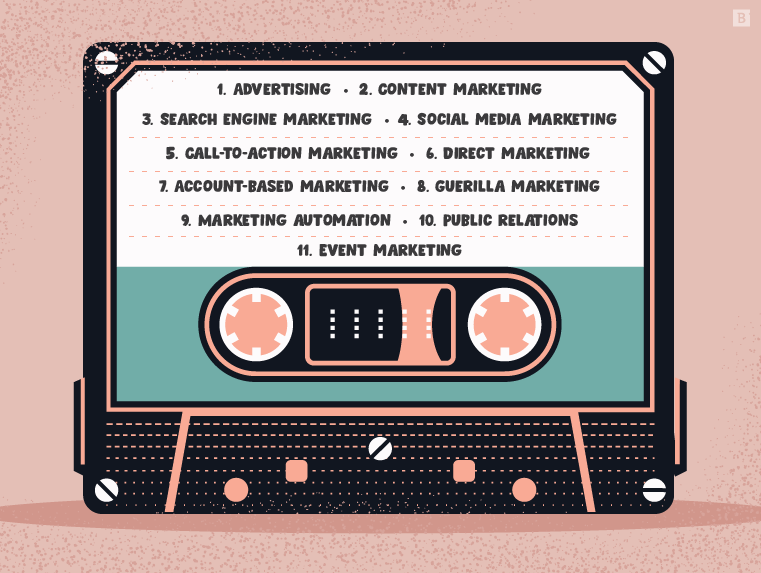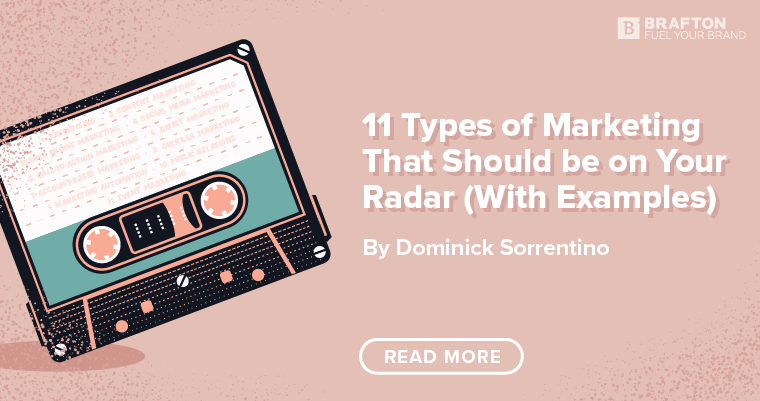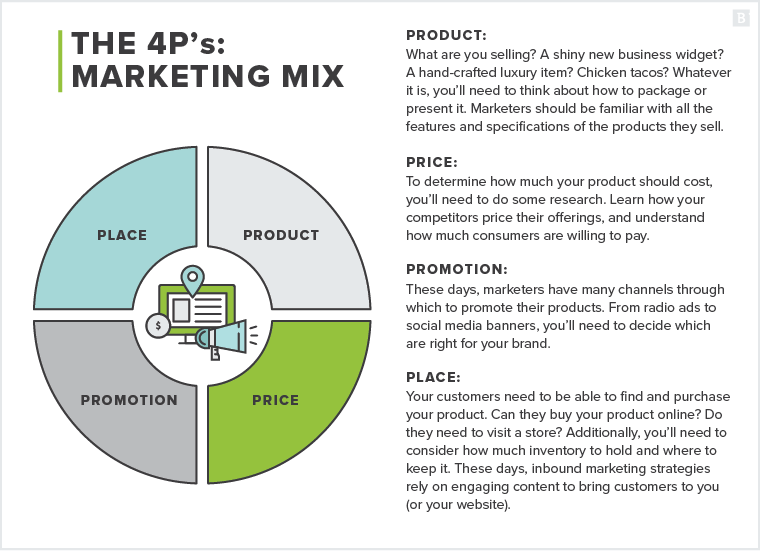Many people confuse advertising and marketing – if you fall into this bunch, fear not, you’re certainly not alone. However, it’s important to know that these concepts:
- Are not interchangeable. Advertising is just one small subset of the bigger, overarching concept of marketing, but we’ll delve more deeply into this in a minute.
- Must be integrated and work together in order to enable the success of the brand.
Too much focus in one area without thought for the other can put your company on a slippery slope. While you may be generating awareness, you may not be fully supporting engagement (or vice versa).
It’s your job as a marketing stakeholder for your brand to understand the distinction between these essential processes, but also know how these strategies work in tandem for the good of the company, its product and service lines and the consumers it wants to target.
Let’s take a deeper look at marketing and advertising, how they’re related yet different, and how you should integrate these approaches to best support your brand.
First things first: What’s the real difference?
Remember when I told you that if you confused the concepts of marketing and advertising, you weren’t alone? If you were to ask 20 marketing professionals to define the difference, you’d likely get 20 different answers.

This is because marketers often mix these concepts together, leveraging one as part of the other in order to craft the right experience and provide for customer needs, while publicizing their company and its offerings. However, when you consider the greater definitions of marketing and advertising, it’s clear that this stirring together of the two isn’t an incorrect approach.
It’s most helpful to look at this way: Advertising is just one key strategy underneath the bigger marketing umbrella.
However, the critical difference here is that the purpose of advertising is to call attention to a particular product or offering. Marketing, on the other hand, is made up of advertising and a whole host of other strategies to support brand awareness, engage the business’s target audience, encourage conversion, and enable repeat purchases and customer loyalty.
In other words, advertising is the loud and colorful TV commercial explaining why a certain product is the answer to all your problems and you just have to have it. But this commercial is just one branch in the brand’s marketing tree.
Other branches extend to the company’s online presence and web design, social outreach efforts, influencer marketing partnerships, and the range of other activities the business takes part in to make its brand known to current and potential customers. All of these efforts are backed with research into the overarching market, particular target audience and more to ensure that the right messaging and approach are used for each piece of marketing collateral (including ads).
Breaking it down further: Marketing as the bigger picture
Let’s take a step back here, and define each of these concepts individually.
Marketing is a multifaceted process that includes activities like market research, public relations, sales strategies, multi-channel advertising and more to support brand awareness and create a connection and unique experience for the target audience. Marketing efforts can have a range of different goals and objectives, depending upon the company, its offerings, its target audience and a variety of other factors.

Check out this article to learn more about the best ways to define your organization’s goals and objectives.
A company’s marketing strategy will certainly include advertising, but ads only represent one chapter of the larger marketing story.
Looking at it another way, marketing – and the processes, research and approaches included – are used to inform the advertisements a team puts together on behalf of its brand. In other words, ads can’t be created until certain marketing efforts are completed to lay the groundwork.
Marketing strategies, including industry and target audience research, tell the marketing team which types of advertisements will best resonate with the customers they’re looking to reach, as well as the channels that these consumers engage with the most.
Marketing, therefore, is the big picture, and functions to support the brand and the experience and engagement opportunities it offers current and potential customers.
Some traditional marketing examples include:
- Direct marketing and similar marketing campaign efforts, like email campaigns.
- Account-based marketing, which can almost be considered a drill-down of direct marketing, but for B2B businesses. This approach focuses marketing efforts around a specific account or business customer to support improved sales cycles.
- Influencer marketing, or the use of a spokesperson to help support brand awareness.
- Inbound marketing and efforts aimed at driving traffic to the brand’s website and other key channels.

Supporting marketing: Advertising brings the message to the audience
This certainly isn’t to say that advertising is not a critical marketing strategy. If marketing and the approaches therein are used to support and inform, then advertising represents the brand putting this research into action.
Once the marketing team has put time, effort and thought into its target audience research and the types of messages that will encourage engagement and (hopefully) conversion, advertising is the strategic communication the brand uses to bring these key messages directly to its audience.
Advertising is also much more focused, revolving around messages related to a particular product or service.
Examples of advertising include things like:
- Print ads appearing in newspapers, magazines or other publications
- Billboards
- Online banner ads
- Social media ads, including paid/sponsored posts
- Radio or television ads
What about campaigns?
We can’t discuss advertising and marketing without touching on campaigns.
Marketing campaigns and advertising campaigns both exist, but just as with the root concepts involved here themselves, these campaigns differ in their purposes and approaches.
A marketing campaign entails the strategy, research, planning and creation of marketing materials. Campaigns that fall under this umbrella aim to support and expand brand awareness, particularly to potential customers that have not yet engaged with the business. Many marketing campaigns are ongoing, and all are key for the consumer experience and supporting the customer lifecycle.
An ad campaign, on the other hand, may include messages across different channels, but the purpose here is to raise awareness around a specific product, as opposed to the brand behind it. Businesses will most often engage in an ad campaign after establishing a new product line or offering, and will leverage the ad campaign to focus attention around the addition to the business’s portfolio.
The four P’s of marketing – and where advertising fits in
Thus far, we’ve used a handful of metaphors to describe the relationship between marketing and advertising, but I’ve saved my favorite for this last part.
Before we get to that, though, we need to lay the groundwork of the main phases of marketing, “the four P’s.” Breaking it down, the four P’s outline the key factors that must be considered and included in brand marketing plans in order for them to successfully attract customers and support the company:

- Product: (or service, but that didn’t start with a P, so for our purposes here, “product” also includes service provider offerings). What is it that the brand is offering, how is it different from competitor products and what pain point or need does it solve for customers?
- Price: How much will it cost? This point is key, as a high-priced good might turn off potential customers where low prices may have shoppers calling into question the quality of the item. This phase also relies heavily on the market and target audience research that we discussed previously.
- Place: Where will it be provided and how will the business get it there? This phase includes considerations around the supply chain and distribution, including in-store purchase availability as well as online channels.
- Promotion: Here’s where we get to the part about advertising. Promotions refer to the messaging, collateral and strategic communication brands use to publicize the product outlined in the first phase – including the advertisements it will create to spread the word about the product and generate interest among its current and potential customers.
Now, the good part: Remember those cute nesting dolls, where each artfully painted, wooden doll opens at the waist, revealing a smaller, cuter doll inside?
Think of marketing as the first, biggest nesting doll. She’s the overarching, bigger concept, with the purpose of supporting the brand and generating awareness among current and potential customers in the company’s target audience. In order to do this, though, she includes a whole host of other strategies. Each smaller doll inside represents one of these other important factors or approaches.
Through the lens of the four P’s, marketing is the largest nesting doll. The second largest doll inside represents the product the brand is offering, the third is the price the brand will charge for that item, and the fourth doll is the place the product will be provided. Finally, the tiniest doll inside represents promotion, or the messaging and advertising the brand will use to support its product.
Each doll plays a specific role, and no set of nesting dolls (or marketing efforts) would be complete without the final, tiniest doll – the promotional advertising used to get the word out and form a connection with customers.
And there we have it!
Marketing and advertising are uniquely distinct concepts, but are heavily intertwined, relying on each other for success. However, you can’t make your way to the tiniest doll without opening the larger dolls, just as a marketing team can’t create winning advertisements without first engaging in the other, key phases of the marketing process.





